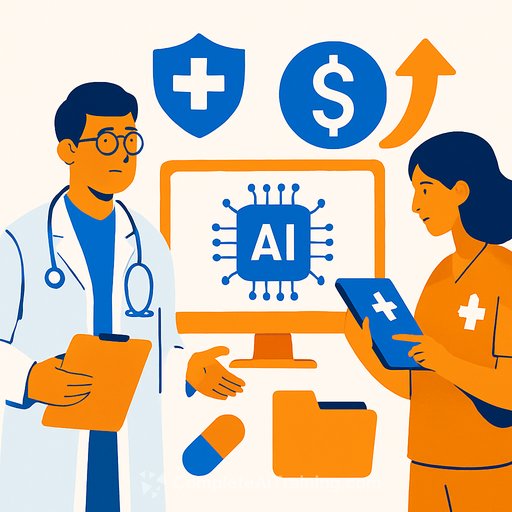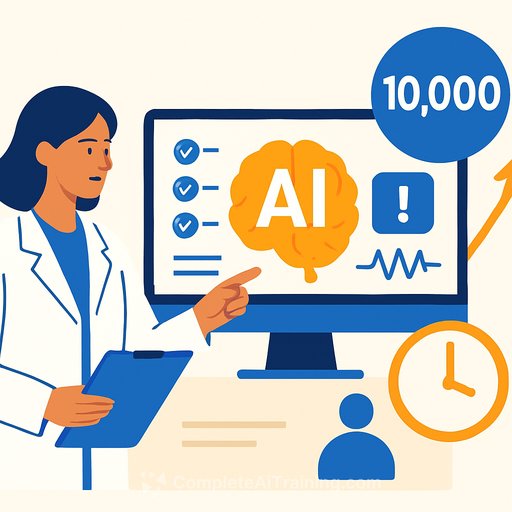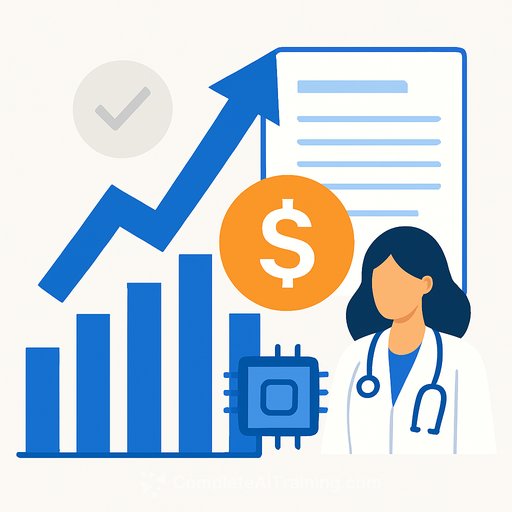Generative AI in Healthcare: Market Outlook to 2035
The market for generative AI in healthcare is valued at USD 3.3 billion and is projected to reach USD 39.8 billion by 2035, a 28% CAGR. Health systems, life sciences, and technology providers are moving from pilots to scaled deployments, aiming for measurable gains in cost, throughput, and clinical quality.
Strategic focus is shifting to outcomes that reduce friction for clinicians and patients. The biggest gains are appearing where AI augments clinical decision-making, shortens documentation time, and accelerates discovery workflows.
Why this matters for healthcare leaders
Healthcare faces compounding issues: inefficient workflows, rising costs, and workforce burnout. In Medscape's 2024 report, 49% of physicians reported burnout; administrative load (62%) and long hours (41%) were top drivers. Source
Drug development remains costly and slow, with about 90% of candidates failing before advanced clinical phases. These headwinds pressure margins and delay patient access to effective therapies.
Where generative AI delivers value today
- Administrative automation: Potential annual savings of ~USD 150 billion sector-wide through automated documentation, coding support, and patient communication.
- Clinical quality: Studies suggest up to 85% reduction in diagnostic errors in targeted use cases, with improved imaging support and decision-assist tools.
- Workforce productivity: Nursing overtime reduction of 21% has been reported, translating to ~USD 469,000 savings over three years per hospital.
- Discovery and development: Faster target identification, molecule design, and trial optimization shorten cycle time and improve R&D efficiency.
- Personalized engagement: More precise education, follow-up prompts, and care navigation tailored to patient context.
Market segmentation highlights
- Purpose: Clinical-based use leads today, reflecting direct impact on patient care and clinician decision support. System-based use (operations, revenue cycle, supply chain) continues to expand as integrations mature.
- Type of offering: Technology/platforms account for the largest share now; services are expected to grow faster as organizations seek integration, compliance, and change enablement.
- Application areas: Treatment leads and is expected to stay on top, supported by improvements to efficacy, safety, and care coordination. Diagnosis, administrative tasks, and drug discovery remain major growth lanes.
- End-users: Healthcare providers generate the most revenue and are expected to retain leadership, driven by direct clinical applicability and enterprise-wide efficiency goals.
- Regions: North America holds the largest share; Asia-Pacific is expected to post the highest CAGR through 2035.
Competition and deal activity
- More than 45% of companies are mid-sized; 79% of those are headquartered in North America.
- Over 85% offer technology/platforms; 27% serve both healthcare providers and P / B companies.
- Partnerships are surging, with close to 90% of deals signed in the last two years.
- Buyer bargaining power is very high; initiatives should be evaluated against near-term value, integration complexity, and total cost of ownership.
- The platform segment holds close to 75% share today; overall market CAGR projected at 28% through 2035.
What to prioritize in the next 12 months
- Target clinical use cases with measurable outcomes (diagnostic support, treatment planning, patient summarization). Define success metrics upfront.
- Start with high-volume administrative pain points (notes, prior auth packets, coding suggestions) to free clinician time quickly.
- Establish strong governance: privacy-by-design, bias monitoring, model versioning, and transparent audit trails.
- Vendor due diligence: security posture, data handling, on-prem/virtual private cloud options, EHR and PACS interoperability, and human-in-the-loop safeguards.
- Operational readiness: clinician training, change management, incident response, and clear escalation paths.
Notable collaborations in action
- NVIDIA × Genentech
- Insilico Medicine × Inimmune
- OpenAI × Moderna
- Amazon Web Services × Pfizer
- Suki × Ascension Saint Thomas
- Abridge × Emory Healthcare
- Google × China Medical University Hospital
Leading players featured
- Amazon Web Services, C3 AI, Exscientia, Google, Huma, IBM, Iktos, LeewayHertz, Medical IP, Microsoft, NVIDIA, OpenAI, Oracle, PhamaX, Syntegra
Report scope
- Purpose: Clinical-based, System-based
- Type of offering: Technology/Platform, Service
- Application area: Drug Discovery & Development, Diagnosis, Treatment, Administrative Tasks, Other
- End-user: Pharmaceutical & Life Science Companies, Healthcare Providers, Other End-Users
- Geographies: North America, Europe, Asia-Pacific, Middle East & North Africa, Latin America
Regional breakouts covered
- North America: US, Canada
- Europe: Germany, UK, France, Spain, Switzerland, The Netherlands, Rest of Europe
- Asia-Pacific: China, Japan, South Korea, Singapore, India, Rest of Asia-Pacific
- Middle East & North Africa: Israel, UAE, Rest of MENA
- Latin America: Brazil, Rest of Latin America
Additional benefits
- Complimentary PPT insights packs
- Complimentary Excel data packs for all analytical modules
- 15% free content customization
- Detailed report walkthrough session with research team
- Free update if the report is 6-12 months old
Explore the full details and methodology here: Generative AI in Healthcare Market: Industry Trends and Global Forecasts to 2035.
If you're building internal capability for AI in clinical and operational workflows, explore curated learning paths: AI courses by job role.
Your membership also unlocks:






